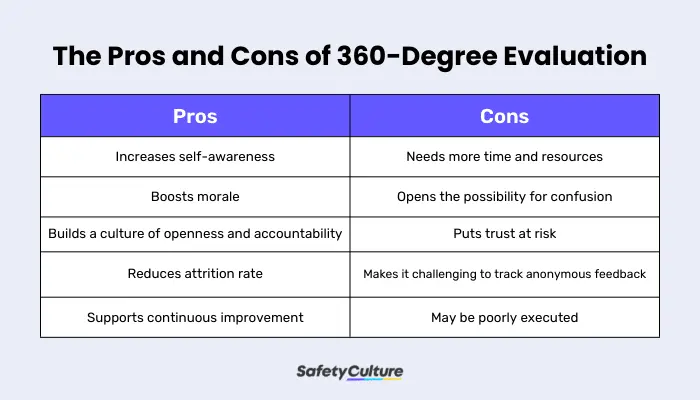What is a 360 Degree Evaluation?
A 360-degree evaluation, also known as multi-rater feedback assessment, is a process and tool used to provide employees comprehensive performance and culture feedback from self-evaluation as well as from those who work around them. These may include their managers or supervisors, peers or colleagues, and direct reports. At times, feedback from customers can also be accounted for. This type of evaluation process is used for developmental and performance appraisal purposes, aiming to help employees improve their work skills and behavior toward better performance and productivity.
Importance
The 360-degree evaluation method may be tailored to what an organization needs to measure and achieve for its employees. In most cases, this feedback method can be used as the following:
- Development tool – A 360-degree evaluation is useful for gaining insights into how workers perform in their jobs, which helps them recognize their strengths and weaknesses.
- Performance appraisal tool – Employers also use the 360-degree evaluation method to measure employee performance and their overall contribution to the growth of the company.
To help achieve an organization’s goal of conducting 360-degree evaluation sessions, those in charge must be able to clearly define the purpose and scope of the evaluation. Given the two different ways it can be used, a 360-degree performance evaluation may improve or compromise the efficiency and quality of an organization’s performance management system.
Moreover, the 360-degree evaluation process has its limitations. To illustrate, here’s a quick overview from Custom Insight of what this type of feedback method measures and what it doesn’t cover:
| What a 360-Degree Evaluation Measures | What a 360-Degree Evaluation Doesn’t Assess |
| Behaviors and competencies | Whether an employee is meeting basic job requirements |
| Others’ feedback on an employee | Technical or job-specific skills |
| Subjective areas such as teamwork, character, and leadership skills | Objective aspects such as sales quotas and attendance |
What are the Benefits of a 360 Degree Evaluation?
So, what’s in it for employers and workers to perform a 360-degree evaluation? Also, what are its disadvantages that should be considered? Take a look at the 360-degree evaluation pros and cons.
Pros
- Increases self-awareness – A 360-degree evaluation allows employees to take an in-depth look at their strengths and weaknesses. This is done not just from how they assess themselves but also from the eyes of their peers and managers.
- Boosts morale – Employees become more motivated once they’re made aware of where they excel and how their work contributes to the organization.
- Builds a culture of openness and accountability – When everyone is empowered to give their feedback, they become more open to helping others succeed and becoming more competent at what they do.
- Reduces attrition rate – Providing continuous feedback for employees toward personal and professional development is a strategic way to increase people’s sense of empowerment, for it establishes ways to address short- and long-term plans for growth.
- Supports continuous improvement – As a tool for uncovering areas for development, a 360-degree evaluation helps give way for incremental changes in processes. These will most likely impact an organization’s success in the long run.
Cons
- Needs more time and resources – Since this type of evaluation is comprehensive and needs input from various stakeholders, it might be time-consuming and demanding on resources required to carry it out more effectively.
- Opens the possibility for confusion – Since it’s a comprehensive type of feedback, some employees, leaders, or anyone who’s involved in the process might find it confusing on what needs to be measured and what aspects shouldn’t be assessed.
- Puts trust at risk – With most evaluation programs like this being anonymous in nature, some employees may not take the feedback seriously. It can also result in dishonesty or inaccuracy.
- Makes it challenging to track anonymous feedback – Highlighted areas for improvement and the overall effectiveness of 360-degree feedback might be harder to address since the source is unknown.
- May be poorly executed – Without clear goals defined for the purpose of conducting a 360-degree evaluation, the process of implementing this program might affect employee productivity and their alignment with organizational standards.

How to Design an Effective Evaluation Program
While the process of creating a unique evaluation program may vary across organizations, using this 7-step guide helps you establish an effective system that suits your objectives:
- Define clear goals – This is necessary to help avoid conflicts of interest, highly negative feedback mechanisms, and unfavorable dynamics between team members, peers, and managers.
- Standardize rating systems – Since the subjective nature of giving feedback may be unavoidable, having standard ratings is helpful in maintaining impartiality during a 360-degree evaluation.
- Implement a strengths-based approach – As much as possible, empower employees by focusing on their natural strengths and how they can maximize those toward continuous development in their craft.
- Practice active involvement – Whenever possible, managers and leaders should be involved in the overall process to help the organization clearly communicate shared goals to various teams.
- Encourage accountability – Do this by educating employees, leaders, and managers on the importance of performance appraisal and their roles in making the evaluation program more effective and successful.
- Identify what to include – This is where you lay the specific items, objectives, and metrics you aim to measure or track based on an employee’s performance.
- Customize – Incorporate your own monitoring model or any other methodology that fits your organization, so long as it’s aligned with the various teams’ specific goals and objectives.
Digitize the way you Work
Empower your team with SafetyCulture to perform checks, train staff, report issues, and automate tasks with our digital platform.
Get Started for Free360 Degree Evaluation Sample
This 360-degree employee evaluation example shows a glimpse of how it works, some sample 360-degree evaluation questions under each aspect, and a few 360-degree feedback examples that raters can give.
| Key Aspect + Question | Self-Assessment | Organizational Leader | Manager | Peer |
| Character
How does the employee act when asked for feedback? |
I make sure to be honest with how I view our current processes not just in the team but also in the organization. | Trustworthy and reliable when asked for areas for improvement when it comes to the overall culture of the organization | Open and generous in giving and receiving process feedback and peer evaluation | Honest and detailed when asked for input regarding deliverables |
| Interpersonal Skills
How are the employee’s dynamics with the team? |
I reach out to my peers whenever I need help and if I can offer assistance in achieving our team’s goals. | Knows how to recognize the value of people with various skills and strengths | Displays good listening skills and treats teammates with respect | Extends help whenever and wherever needed |
| Talent-building
How does the employee work on personal and professional development? |
I document and work on relevant feedback I receive from my peers, manager, and leader to monitor my progress. | Proactive in inquiring about and suggesting how the management can support employee development | Reaches out whenever an opportunity for learning and growth is available | Takes the initiative to share learnings with the team |
| Leadership and Motivation
How does the employee display traits of being a team player as well as a leader? |
I own certain initiatives to help my team continuously meet targets and exceed shared objectives. | Good in making decisions that are aligned with business needs | Takes the lead to bring action that helps the team to better address challenges and improve processes against targets | Not afraid to reach out and suggest ways how to improve the way we do our tasks |




